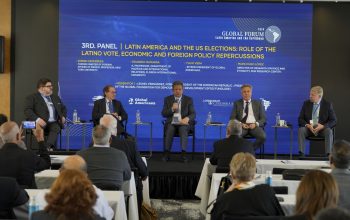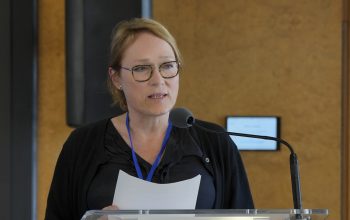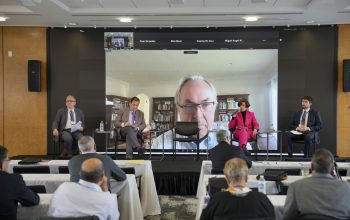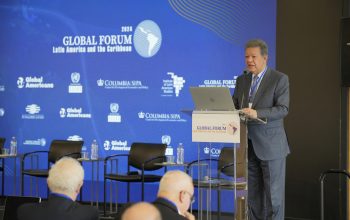news
“On the 100th Anniversary of the Bolshevik Revolution”, an article by Dr. Leonel Fernández
October 26, 2017
Mikhail Gorbachev, the man who was destined to save Socialism in the Soviet Union through the realization of political and economic reforms such as glasnost and perestroika, instead ended up becoming the man who would dig its grave.
For current Russian President Vladimir Putin, the collapse of the Soviet Union, which gave way to the formation of 15 independent and sovereign nations, was the greatest geopolitical
tragedy of the 20th Century.
Notwithstanding, what happened in Russia exactly 100 years ago, in October of 1917, was a seismic movement; a tectonic change in the politics of not only of the Russian Empire but also around the world which led the Bolshevik Party, a minority group, under the direction of Vladimir Ilyich Ulyanov (Lenin) to take power.
For some analysts, what determined the triumph of the Bolshevik Revolution in October 1917 was the collapse
of the Imperial Russian Army during WWI; a period from 1914 to 1918 in which more than 2.5 million Russian soldiers perished against the German army as it advanced towards Moscow.
But even before the outbreak of World War I, Tsarist Russia showed signs of malaise as a result of the monarchy’s suppression of civil liberties and requirement that peasants be tied to the land for the benefit of the aristocracy.
These conditions further
deteriorated as a result of the 1894 accession to the throne of Nicholas II, the most unfit, dim-witted, and blundering of all the members of the Romanov Dynasty, which had boasted three centuries of rule over the Russian Tsardom and Monarchy.
Another cause for unease was the outcome of the Russo-Japanese War of 1904 to 1905, which led to Russia’s defeat at Japanese hands and the obligation of Russia to abandon its policy of expansion towards the Far East. The
event was cause for great humiliation, as Russia had become the first historical example of a European power which had been overcome by an Asian power.
Three Revolutions
After its defeat in the Russo-Japanese War, the Russian Monarchy saw itself losing its authority. As a result, the deterioration of the economic and social situation in the country became ever more critical.
As the discontent of various social groups grew
larger, support for Nicholas II appeared to fracture.
Amidst this situation, In January of 1905 a group of unarmed protestors led by Father Georgy Gapon, a popular Russian Orthodox priest, was fired upon as they peacefully marched towards the Winter Palace, the St. Petersburg seat of the monarchy, to demand political reform.
The protestors’ march culminated in what would later be referred to as Bloody Sunday; a day in which hundreds of people
were senselessly riddled with bullets, and which for the rest of the year kept the country in a state of permanent agitation.
To resolve the crisis, Tsar Nicholas II arrived at a political agreement with the various sectors of the nation. By virtue of the agreement, dubbed the October Manifesto, Nicholas II consented to the approval of a Constitution, the elimination of all restrictions of the exercise of public freedoms, and the establishment of a Duma, or
Parliament.
The agreement reduced tensions, stabilized the political situation, and guaranteed the Romanovs’ hold on the monarchy.
But as previously stated, less than a decade later, in 1914, World War I erupted; and the conflict ended up being decisive for the future of Tsarist Russia.
The Imperial Russian Army was decimated during the war. The casualties piled up.
It experienced hunger and cold; there
was no faith in the possibility of victory. Some soldiers deserted while others were executed for refusing to go to the front lines. Morale was low. The country disintegrated.
As a result, protests began anew. Multitudes took to the streets, and were severely repressed. But afterwards, instead of quelling the protests, those charged with maintaining control joined in the fray.
The workers organized themselves into Councils, or Soviets. The Tsar saw
himself compelled to abdicate the Throne, and the crown prince did not wish to succeed him. A provisional government, headed by a liberal reformist – Georgy Lvov, was formed. Thus, three centuries of the Romanov Dynasty had arrived at their end. The February Revolution of 1917 had triumphed.
Meanwhile, the leader of the Bolsheviks, Lenin, who had stayed in Switzerland during the war as a refugee, returned to his home country in the beginning of April aboard a
“sealed” German train.
Upon his return to Russia, Lenin launched a series of 10 directives (his April Theses), in which the Bolshevik leader proposed yet another revolution, but this time with a more defined concept: all power to the Soviets.
During the following six months, all of Russia plunged into chaos. In rural areas, peasants rose up to take control of the land, and in cities, workers took control over the
factories. Soldiers joined in society’s great struggle.
In the month of July, a revolutionary Socialist, Alexander Kerensky, became the second Minister-Chairman of the provisional government. However, to stem the anarchy, he wanted to reestablish order and authority through the reimposition of the death penalty and martial law. And as an uprising against the provisional government of Kerensky failed, Lenin had to flee once more, this time taking up exile in
Finland.
But suddenly, Lenin returned in an environment of political radicalization where the Bolsheviks constituted a majority in Soviets throughout St. Petersburg, Moscow, and other cities.
Under the slogan of "Peace, Bread, and Land" , on October 26th, 1917, 100 years ago to the day, the Bolsheviks overthrew the provisional government of Alexander Kerensky, and the Soviets took control of Congress.
In 12 years,
from 1905 to 1917, Russia had experienced three revolutions.
In the last one, which saw the triumph of the Bolsheviks, a new chapter of history began not only in Russia, but around the world.
Rise and Fall of the Soviet Union
The most important event resulting from the Bolshevik Revolution was the creation of the Union of Soviet Socialist Republics (USSR), an amalgamation of 15 nations that had up until that point existed
autonomously or independently.
To be certain, before the Soviet Union’s proclamation, the Red Army faced off against the White Army in the Russian Civil War. Afterwards, a change of economic policy was announced by Lenin (the so-called New Economic Policy) which permitted the establishment of market mechanisms in some sectors of the national economy.
For the nascent Soviet Union, the premature death of Lenin in 1924 was a crushing blow.
However, from that moment until 1953, power gradually passed to the General Secretary of the Central Committee of the Communist Party of the Soviet Union, Joseph Stalin.
Under Stalin’s regime, the great revolutionary leaders Leon Trotsky, Nicolas Bujarin, and others, were purged. However, Stalin’s three decades of rule also saw the collectivization of agriculture and the development of heavy industry.
In the era of Stalin, the Soviet
Union, which initially made a pact with Adolf Hitler, ended up fighting alongside the Allies in World War II; and in spite of having lost more than 20 million soldiers in the carnage, emerged from the ashes, alongside the United States, as one of the world’s great superpowers.
At the end of World War II, resulting from the occupation of the Red Army, Socialism extended throughout Eastern Europe. Subsequently, Socialist ideals influenced the triumph of the
Chinese Communist Revolution in 1949, the beginning of the Korean War in 1950, the defeat of the French in Indochina in 1954, and many of the processes of decolonization and struggles for national liberation in Africa, Asia, the Middle East, and Latin America.
In the 1950s, 60s, and 70s, the Soviet Union seemed to captivate the world. It advanced at a remarkable pace, and even took the lead in the Space Race.
But beginning in the 1980s, its economy
began to stagnate.
Then, In 1989, the Berlin Wall fell. The popular democracies of the Eastern Bloc followed suit.
Suddenly, without firing a single bullet, on December 25th, 1991, the Union of Soviet Socialist Republics ceased to exist.
In spite of the failure of the Soviet experiment, 100 years after the Bolshevik Revolution, humanity has not ceased its search for new utopias to create and new dreams for which to fight.
Because in the end, humanity recognizes that another world is achievable: one that is more just and more humane.






